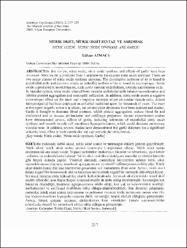Nitrik oksit, nitrik oksit sentaz ve sarımsak
Abstract
ln this review, nitric oxide, nitric oxide synthase and effects of garlic have been reviewed. Nitric oxide is produced from L-arginine by the enzyme nitric oxide synthase. There are two major classes of nitric oxide synthase enzymes. The constitutive isoforms of its is found in endothelial cells and nevrons, where as inducible isoform of its is found in macrophages. Nitric oxide is produced in several tissues, such as the vascular endothelium, neurons and immune cells. In vascular system, nitric oxide released from vascular endothelial cells induces vasorelaxation and inhibits platelet aggregation and neutrophil infiltration. In addition, nitric oxide exerts a negative chronotropic effect on the heart and a negative inotropic effect on cardiac muscle cells. Allium sativum (garlic) has been employed as an herbal medicinal agent for thousands of years. The main active agent in garlic extracts is allicin, but several other chemicals have been isolated and studied. Garlic is thought to decrease blood pressure, inhibit platelet aggregation, reduce blood fat and cholesterol and to possess antibacterial and antifungal properties. Recent experimental studies have demonstrated several effects of garlic, including activation of endothelial nitric oxide synthase and smooth muscle cell membrane hyperpolarization, which could decrease pulmonary vascular tone. In addition, several studies have demonstrated that garlic dialysate has a significant antiarrhythmic effect in both ventricular and supraventricular arrhythmias. Bu makalede, nitrik oksid, nitrik oksit sentaz ve sarımsağın etkileri gözden geçirilmiştir. Nitrik oksit, nitrik oksit sentaz enzimi vasıtasıyla L-argininden oluşur. Nitrik oksit sentaz enziminin iki ana sınıfı vardır. Yapısal izoformları endoteliyal hücreler ve nöronlarda, uyarılabilir izoformu ise makrofajlarda bulunur. Nitrik oksit vasküler endotelyum, nöronlar ve immün hücreler gibi birçok dokuda yapılır. Vasküler sistemde, endoteliyal hücrelerden salman nitrik oksit vazoreleksasyon oluşturur, trombosit agregasyonunu ve nötrofıl infıltrasyonunu inhibe eder. Nitrik oksit direkt damar düz kası hücrelerini gevşeterek kan damarlarını dilate eder. Ayrıca, nitrik oksit kalpte negatif bir kronotropik etki ve kalp kası hücrelerinde negatif bir inotropik etki ortaya koyar. Sarımsak binlerce yıldır bitkisel ilaç olarak kullanılmaktadır. Sarımsak ekstrelerindeki temel aktif madde allicindir, ama başka birçok kimyasal madde de izole edilip incelenmiştir. Sarımsağın kan basıncını düşürdüğü, trombosit agregasyonunu inhibe ettiği, kan yağ ve kolesterolünü azalttığı, antibakteriyel ve antifungal özelliklere sahip olduğu düşünülmektedir. Son deneysel çalışmalar, endotelial nitrik oksit sentaz aktivasyonu ve pulmoner vasküler tonüs azalmasına neden olan düz kas hücresi membran hiperpolarizasyonu dahil, sarımsağın birçok etkileri olduğunu göstermiştir. Ayrıca, birçok çalışma sarımsak dializatlarının hem ventriküler hemde supraventriküler aritmilerde, önemli bir antiaritmik etkiye sahip olduğunu göstermiştir.
Source
Afyon Kocatepe Üniversitesi, Kocatepe Tıp DergisiVolume
2Issue
3Collections
- Makaleler [452]



















